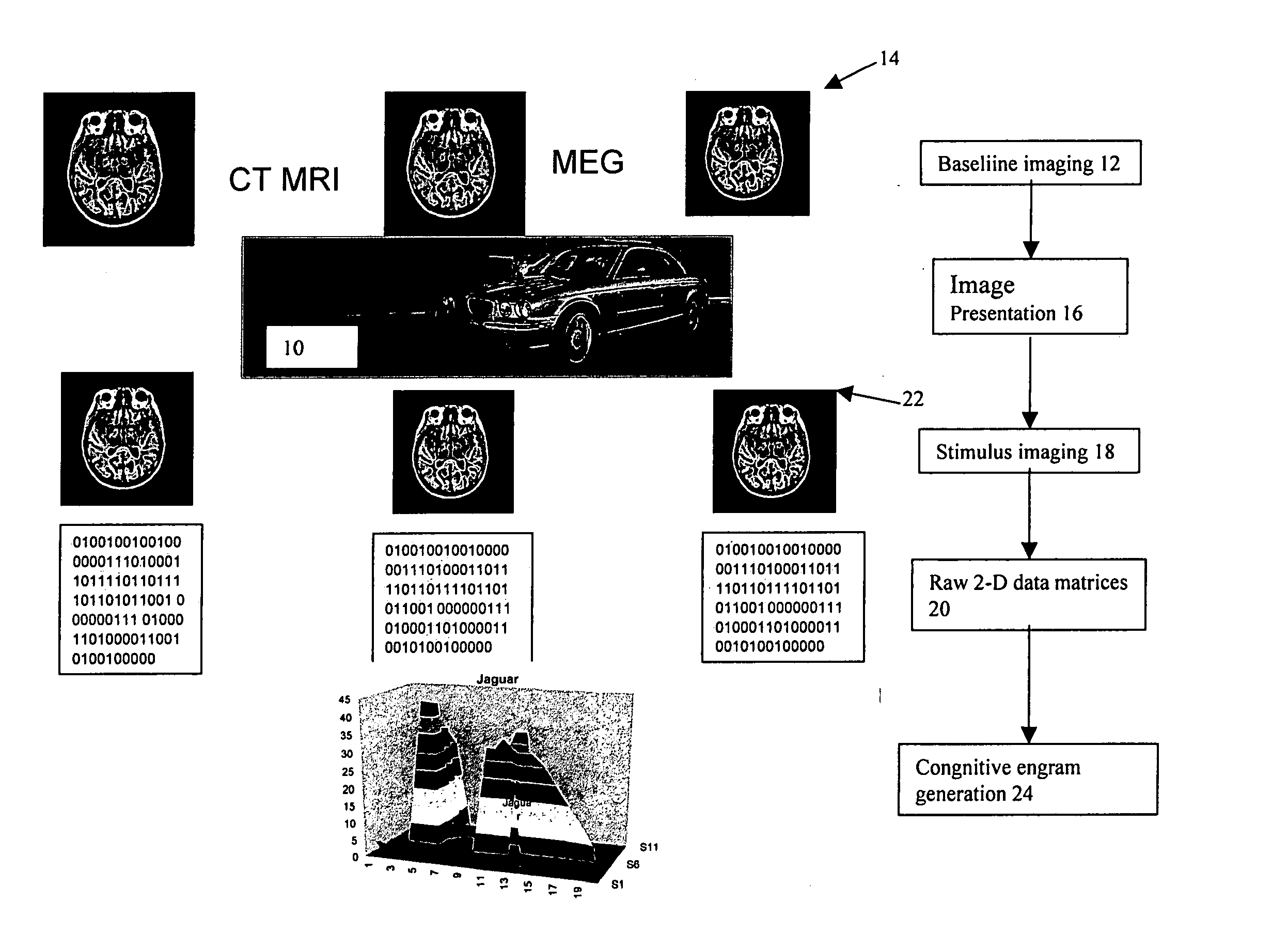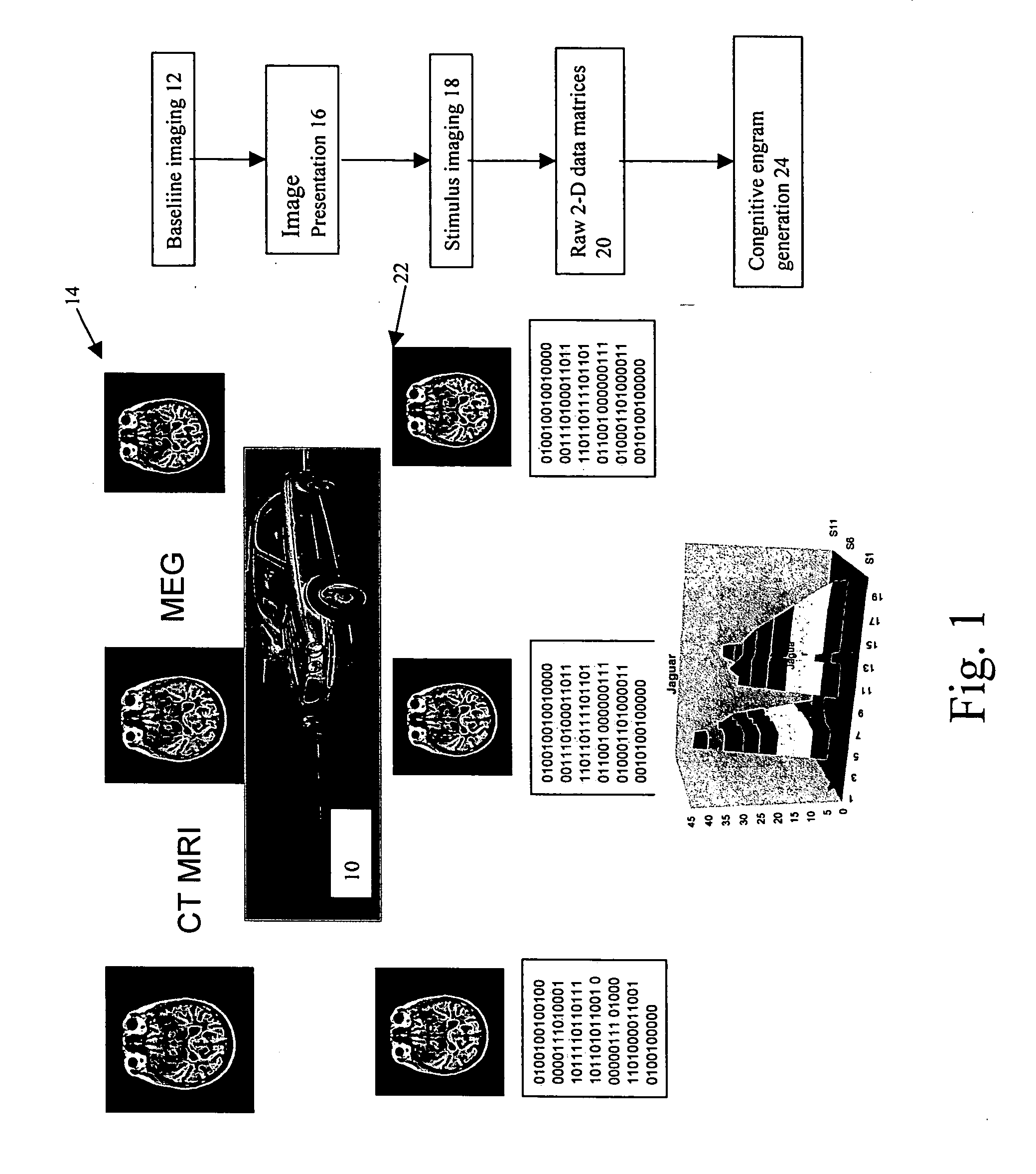Brain function decoding process and system
a brain function and decoding technology, applied in the field of neuroimaging data analysis, can solve the problems of limited resolution, inability to understand how individual brain imaging localizes below the general brain region area of activation, and cannot be applied in medical science, diagnostics, and psychotechnic devices. to achieve the effect of reading the neurologic activity of an individual
- Summary
- Abstract
- Description
- Claims
- Application Information
AI Technical Summary
Benefits of technology
Problems solved by technology
Method used
Image
Examples
example 1
Cognitive Engrams Extracted from Existing Studies
[0059] Recent scientific publications utilizing fMRI to study neurocognitive functions were located by searching the National Library of Medicine. Publications which detailed the specific coordinates of activation areas for visual objects were selected, and are described below. Three-dimensional graphical surface and bubble point representations of the activation maps were constructed by plotting the xyz coordinates. The xyz coordinates were supplied by all three sets of investigators using the normalized space of the Talairach and Tournoux brain atlas (1988).
[0060] All of the publications whose data was reprocessed presented test objects to test subjects while lying in an MRI scanner, using a flat panel display situated to allow visibility during scanning.
[0061] Bernard et al. (2004) studied the presentation and processing of visual imaging of famous and non-famous faces. The study used an event-related fMRI design, utilized a 4-T...
example 2
Distinguishing Cognitive Engrams of Standard Faces
[0064] A 3-T General Electric Signa Excite scanner with whole head coil is used. Changes in the blood oxygen level dependent T2*-weighted MRI signal are measured using a gradient-echo echoplanar sequence. In each time series, 18 (128×128) or 28 (64×64) contiguous axial slices are obtained. There are three sets of scans performed per experiment: localizer, MRI for functional data, and high resolution anatomic.
[0065] The subject lies in the MRI scanner, wearing a phased array MRI head coil as part of the regular head scan. Mounted on the head coil is a 45 degree mirror, allowing them to see down toward their feet and view the test images. Displayed near the bottom of the subject's feet is a large photo, or a white blank paper board, which can have a large X marked across it, which is totally within the field of view of the test subject lying in the scanner. Other means of presentation of visual test images include a goggle image proj...
example 3
Sample Interrogation Protocol
[0077] Background information is obtained on the subject's name, age, sex, SSN, birth city, medications, current and past illnesses, psych history, criminal history, accusation. Then, a basic set of standard images is presented to the test subject while undergoing neuroimaging, in order to obtain a background pattern of activation. Individual responses to questions are recorded via a number of techniques, including verbal and pressing of buttons on handgrips. The test subject is presented with between ten to twenty test questions, and asked to supply intentionally deceptive and intentionally truthful responses to each question.
[0078] The test subject is presented with case-specific questions, with accompanying images / displays of words and phrases concerning: [0079] Facts about their own personal life, name, sex, age, SSN, residence, criminal history; and [0080] Specific photos / questions / statements relating to the subject at issue, including potentially...
PUM
 Login to View More
Login to View More Abstract
Description
Claims
Application Information
 Login to View More
Login to View More - R&D
- Intellectual Property
- Life Sciences
- Materials
- Tech Scout
- Unparalleled Data Quality
- Higher Quality Content
- 60% Fewer Hallucinations
Browse by: Latest US Patents, China's latest patents, Technical Efficacy Thesaurus, Application Domain, Technology Topic, Popular Technical Reports.
© 2025 PatSnap. All rights reserved.Legal|Privacy policy|Modern Slavery Act Transparency Statement|Sitemap|About US| Contact US: help@patsnap.com



